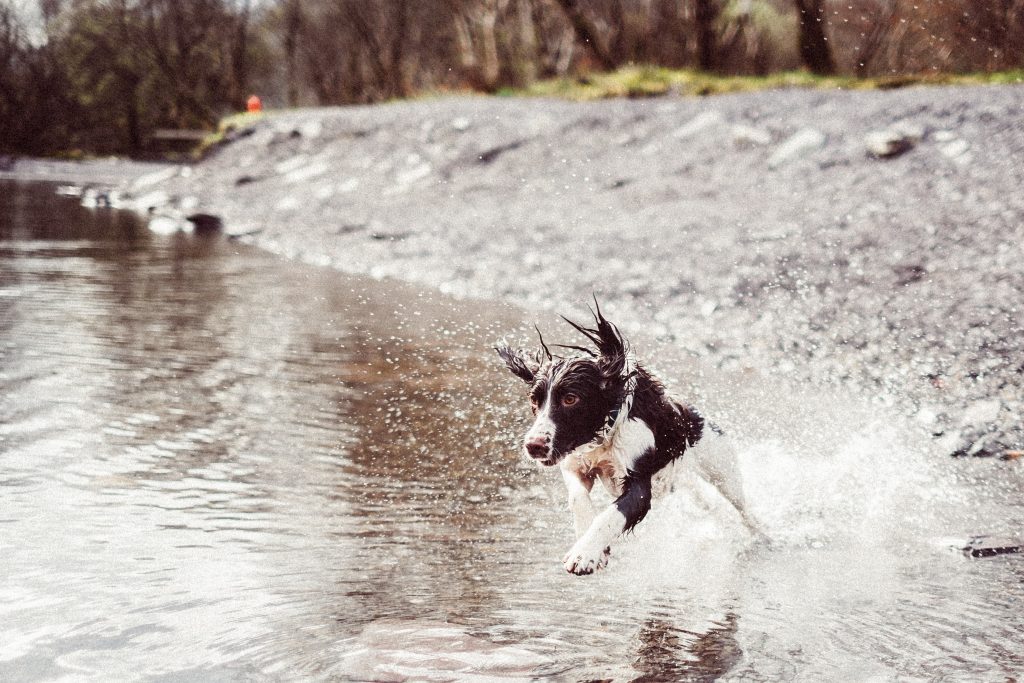Does your dog experience sudden bursts of energy and excitement? One minute your dog may seem normal, and the next minute they are racing through the house for no apparent reason.
These outbursts are often referred to as the zoomies. This behavior is quite common in dogs but can sometimes be concerning for dog owners. Luckily, there is no need to worry. This article will discuss why dogs get the zoomies and what you should know about this canine behavior.
In this guide, we’ll cover:
What are zoomies?
The scientific name for the zoomies is frenetic random activity periods (FRAPS). The random activity periods are a natural behavior characterized by sudden bursts of excess energy.
These frenetic random activity periods have been documented in many animals but are most frequently observed in dogs.
Dogs experiencing the zoomies may run in fast circles, jumping on the couch or other objects in their path. Many owners describe their dog as having a frenzied or crazed expression during this time.
These bursts of energy can occur inside or while out playing in the yard. They’re typically short-lived and only last a minute or two, but are a dog behavior phenomenon that leads owners to question why their dog runs and play bows at high speed.
As Animal Behaviorist Jill Goldman explains in The American Kennel Club:
“They are bursts of energy like a volcano. Energy builds up then there is the expression and release of that energy.”
Younger dogs are most likely to get the zoomies–running around the house at full speed (maybe even into the coffee table). But the fun doesn’t last long. Senior dogs, or those grown out of the puppy stage, usually outgrow the zoomies behavior. (If they don’t, there’s a chance your dog isn’t getting enough mental stimulation. More on that later.)
Are zoomies safe?
The zoomies are a natural behavior that all dogs experience. Zoomies are typically associated with excitement and positive energy, hence why your dog may get the zoomies after playtime.
Veterinary behaviorists agree that zoomies are normal and should not be considered a behavioral concern. Zoomies occur in all dog breeds and all ages. High-energy dog breeds such as Labradors and Spaniels may experience the zoomies more frequently.
However, some theories suggest that zoomies can be a release of pent-up energy and stress.

What triggers dog zoomies?
Let’s take a look at five common reasons why dogs get zoomies.
Over-excitement
Although zoomies are considered random activity periods, when your dog is most likely to get the zoomies can be somewhat predictable. Typically this occurs after your pet has been sedentary for a while or inactive. When your dog has spent the day home alone on the couch or in their crate, for example, the excitement of being let out can trigger the zoomies.
Many dog owners notice their dog gets the zoomies as soon as they return home from work or after being away for some time. While this can be due to the excitement of getting let out, your dog’s excitement may also be the result of seeing someone they care about. Dogs are highly social animals and become very attached to their owners. Even after a short time, being reunited can provoke joy and extreme bursts of energy.
Over (or under) stimulation
Another common scenario when dogs get the zoomies is after they have received a bath. This particular scenario is associated with a release of the nervous energy that many dogs build up during the bath time experience. Other experts believe that the post-bath zoomies may be an expression of excitement from feeling clean and refreshed.
The same is true for dogs who don’t get enough exercise or mental stimulation–both of which drain their energy, leaving minimal left for zoomies. If your dog isn’t getting the minimum recommended minutes of exercise for their breed (Sprockers need 60 to 90 minutes of exercise, at least), you may notice that zoomies happen more often.
Learning from other dogs
Just like any extreme emotion, the energy of the zoomies can be contagious. When interacting with dogs at the dog park, one dog may start to get the zoomies and seemingly spread them to the rest of the group.
Health issues
Occasionally, these intense spurts of energy may not be zoomies. In some cases, high anxiety dogs can develop obsessive-compulsive behaviors that mimic zoomies. Even more rarely, this behavior may be indicative of a neurological issue.
Although this is rare, if you have concerns about your pet’s behavior or anxiety, it is always best to consult with your veterinarian. The likelihood is that your pet is exhibiting very normal behavior, but it never hurts to be observant and ask questions about your pet’s health.

How to manage a case of the zoomies
Unsure where the zoomies are manageable? After all, having a dog that runs around like a maniac can result in your dog hurting themselves or young kids in the home. Here’s how to manage a case of the zoomies.
1. Identify zoomie times
Eliminating the zoomies can be difficult and may not be in the best interest of your dog. Instead, determine when your dog typically experiences the zoomies and what is causing the behavior.
The most common complaint from dog owners about the zoomies is that their dog inadvertently damages furniture or other household objects during these bursts of energy. Dogs may jump over couches, kick up rugs, or knock over lamps in their frenzied state. The zoomies are all fun and games until a family heirloom gets damaged.
2. Create a safe space
Next, create an environment that is safe for your dog to release their energy. If possible, learn when your dog most commonly experiences the zoomies and send them outside to get that energy out in an open and safe area.
If you don’t have a safe outdoor space, try moving fragile objects out of the way and clear a path for your pup to have a little fun. Make sure you have a fenced yard if they add a few leaps and bounds to their zoomies.
Another concern with the zoomies is dogs injuring themselves and others. Your dog’s paws may be slippery after a bath and make them more likely to slip and fall.
Make sure you thoroughly dry their feet after a bath and avoid slippery surfaces. Small children or elderly adults may be at risk of getting knocked over by a dog experiencing the zoomies.
Find a safe place to let your dog get out their pent-up energy without running into people who may have a difficult time getting out of your dog’s erratic path.
3. Help them burn energy in other ways
Increasing your pet’s daily activity can also reduce the frequency and intensity of the zoomies.
Physical activities could include anything from long walks to playing fetch, both of which are great outlets to burn a dog’s extra energy.
But remember that some dogs get fitter and fitter the more physical exercise they do. Over time, it takes more work to tire them out–meaning zoomies happen even if you’ve taken them on a five-mile work.
Combine your physical activities with mental stimulation games like:
- Scent work
- Hide and seek
- Find the treat
- Stuffed Lickimats or KONGs
- Agility
- Learning new tricks
Dog zoomies are normal
If your dog is experiencing the zoomies, there is no reason to be concerned. Zoomies are simply a part of being a happy dog.
While some owners may find them concerning or disruptive, the zoomies provide an essential outlet for your pet to release pent-up energy in both young dogs and older dogs.
Creating a safe environment for your pet to exhibit this behavior is critical to prevent them from damaging household items, themselves, or others.
Increasing exercise and other outlets for your dog to release their energy can reduce the frequency of the zoomies but is not likely to eliminate them. If you have concerns about your dogs behavior, don’t be afraid to consult a veterinarian or dog training expert.


